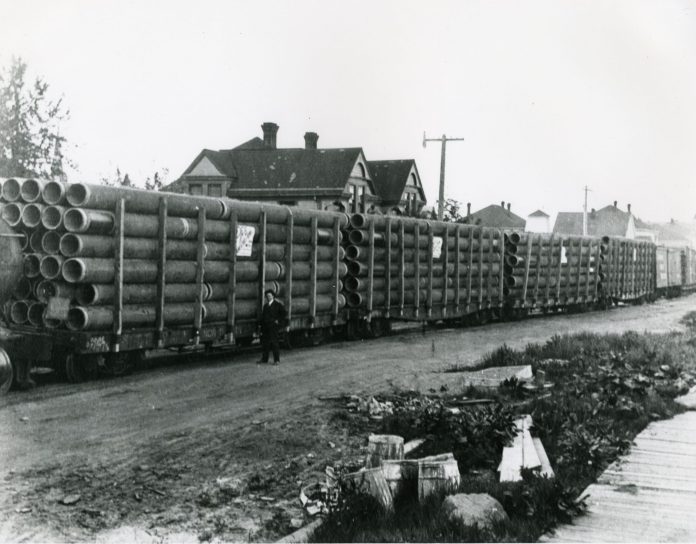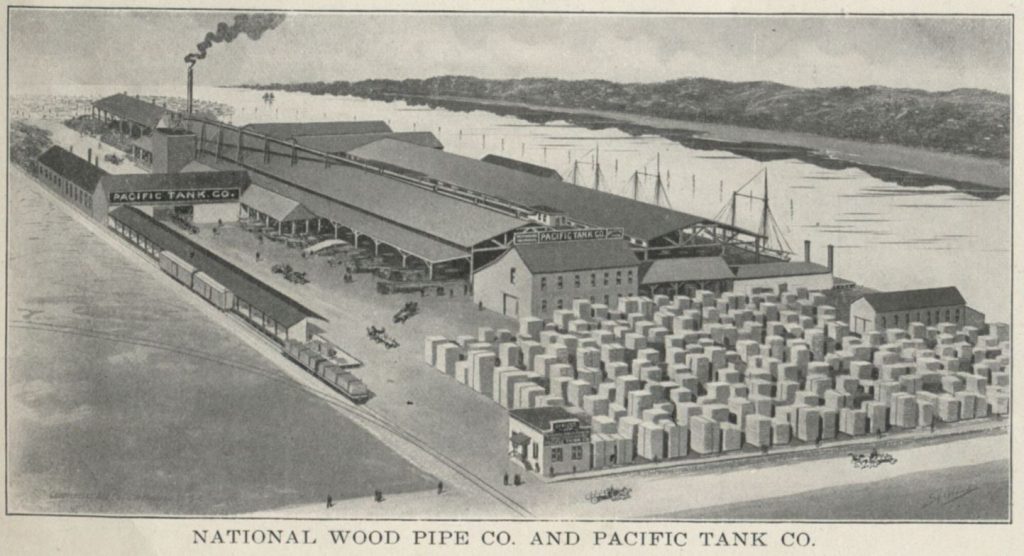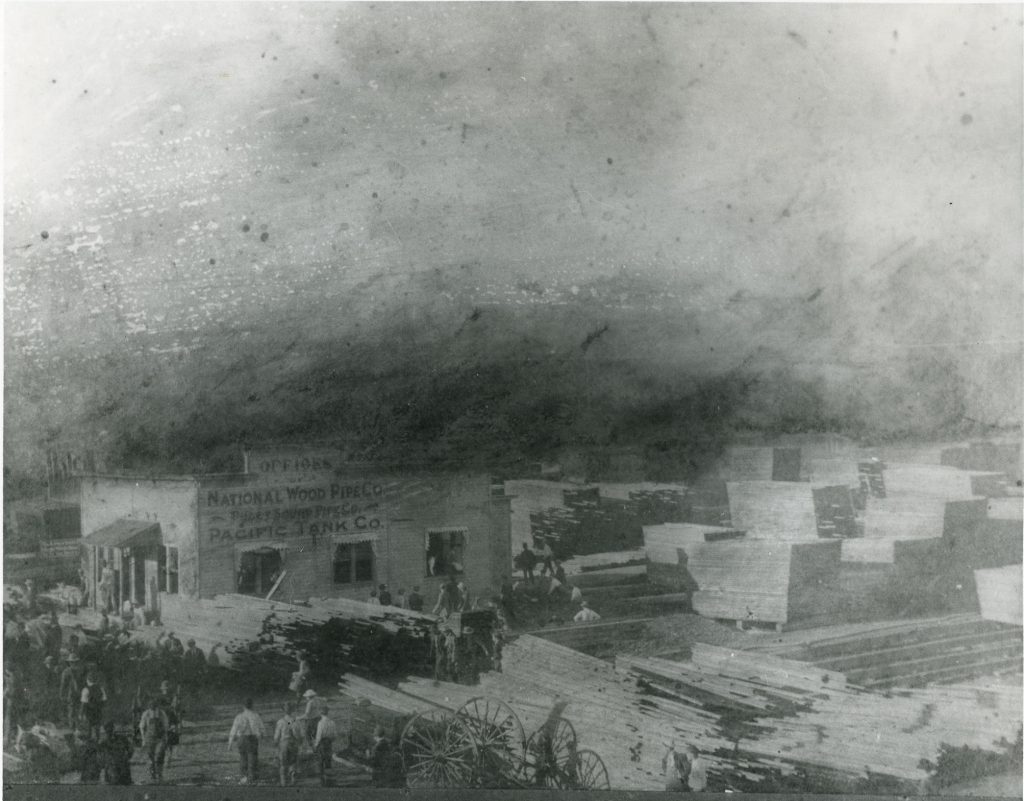
In the early 20th century, timber was king in Thurston County. Sawmills lined Olympia’s waterfront. Fires were frequent. Located at the foot of Jefferson Street, the National Wood Pipe Company had taken every precaution. But on a hot day in July 1909, it would prove to be not enough.
Puget Sound Pipe Company: Tumwater Origins
The company traced its origins to the Olympia Water Company, a wooden pipe factory built by William N. Horton in Tumwater in 1869. Going through many changes in ownership and name over the decades, it eventually became the Puget Sound Pipe Company.
The company produced bored pipe and stave pipe. Water pressure was controlled with metal bands. All pipes were coated with a preservative layer of highly flammable tar.
One of Olympia’s leading industries, these wooden pipes were used for far more than the city’s water system alone. They were utilized for water systems, irrigation networks and mining operations throughout the Pacific Northwest and even as far away as Alaska, Hawaii, Georgia, Mexico and Japan. Some pipe was even used for telephone conduits.
National Pipe Company
In 1904 Puget Sound Pipe Company was bought by the National Wood Pipe Company of Los Angeles. The owners invested in new machinery and enlarged the plant. With business going so well, they even hoped to tear the factory down and rebuild it someday.
Company president W.E. Hampton was on a visit to Olympia with his wife when the San Francisco earthquake hit, damaging the company’s factory there. The Olympia plant donated $100 to the city’s relief efforts. Some local investors hoped the San Franciso operations would be moved to Olympia, but the California factory soon reopened.
The Olympia plant continued to do good business. Also, National Wood Pipe Company’s subsidiary Pacific Tank Company started manufacturing wood storage tanks for things like oil, gas and wine. To meet their growing power needs, they built their own steam power plant in 1908.
The next year the Olympia factory even won a gold medal at the AYP Exposition in Seattle.

Olympia Fire 1909
Work was dangerous, and newspapers recorded frequent accidents, some fatal. Safety precautions were minimal. But what lumber mills feared the most was fire.
Fearing a bad summer in 1906, local mills petitioned for 1,000 feet of reserve hose stationed on Fourth Street near Jefferson. The Olympia Fire Department had only 3,000 feet of hose and two working ladders. This would not save the Pipe Company’s neighbors, the H.G. Richardson Shingle Mill and the Springer Mill from fires that year.
In 1907 the Pipe Company installed auxiliary fire alarms that would send signals from strategic spots throughout the plant to the nearest city fire alarm box, which would call the fire department. That same year they were heavily damaged by a fire that destroyed the neighboring Olympia Door Company. A winter gale later toppled a smokestack, starting a small roof fire.
July 3, 1909, proved hot, dry and windy. Most workers had left for the day but some remaining were loading train cars with finished pipe. Smoke began to billow up from the boards that held much of the plant over the water. Then they spotted flames. The time was 5:45 p.m.
An alarm was called, but the fire quickly spread to the main plant. Burning metal barrels of tar exploded, propelling them hundreds of feet away and showering the area with burning tar. Toxic smoke choked the air. Workers shoved 50 more barrels of tar into the bay out of the way of the flames. Train cars carrying pipe caught fire and proved nearly impossible to extinguish. While moving non-burning cars away from the flames, a train engine severed a firehose (12 were used against the fire).

The whole plant was engulfed in minutes, witnesses later recalled. One hundred volunteer firefighters battled the blaze, helped by the Tumwater Fire Department and—arriving late from a picnic at Rice’s Beach—the Fifth Ward Boys’ Fire Department.
The mill was considered a loss from the start. Firefighters concentrated on protecting the lumber yards and the recently rebuilt Springer Mill. Its workers jumped into action to help.
The wind carried flaming embers and burning tar a mile and a half away, starting additional fires across the water on the Eastside. Sixty homes were damaged. The J.F. Bryan Grocery at Fourth and Eastside Streets was destroyed. Rosalie Goldenberger, a widow with three children, lost her home. She had just finished paying off the mortgage. Firefighting response to the Eastside was delayed until reserve hose could be brought. A patrolman and a volunteer firefighter were seriously injured by falling debris.
The fire department was praised for its response and for Chief E.B. Raymond’s bravery, leading from where the fires was thickest. It was considered among the worst fires the city had yet faced.
National Pipe Company Legacy
All but the engine and dyamo house were destroyed. The company’s losses amounted to about $150,000. Initially, the company promised to rebuild. But that did not happen. In the end, the National Pipe Company decided that the Olympia plant lacked adequate export facilities to make it worthwhile. Outraged local investors tried to start a wooden pipe company of their own, but plans never got far.
Today Olympia’s waterfront is a very different place. The Hands On Children’s Museum now sits where the National Wood Pipe Company once stood. While wood pipes have been long replaced with metal and plastic, old wooden pipes are still occasionally found during local construction projects. History, it seems, is right under our feet.
Check out other local Thurston County history articles here.


















































